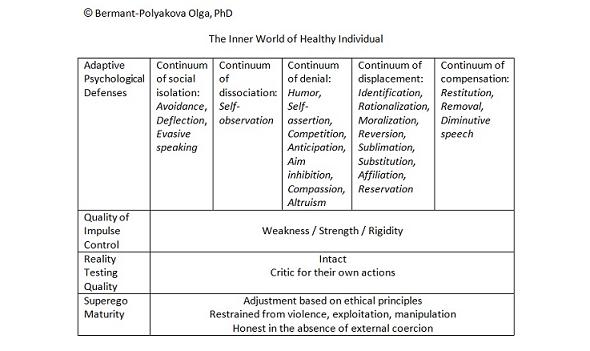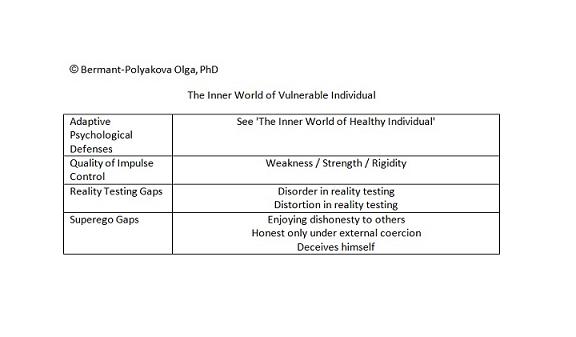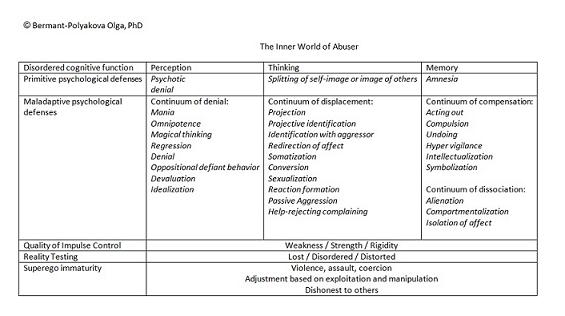Всё самое интересное на сайте olga.co.il
Всё самое интересное на сайте психолога, психотерапевта Ольги Бермант-Поляковой собрано на Карте сайта olga.co.il
Психодиагностика по принципу "миров"
В экспертной психодиагностической практике клинические диагностические модели не могут дать ответа на вопрос, интересующий суд: здоров или нездоров обследуемый? Отправной точкой для составления рабочих схем трёх внутренних миров послужили идеи Ф.Е. Василюка о типологии "жизненных миров" и типологии переживания кризисов в зависимости от "жизненного мира" человека, идеи И.В. Боева о комплексах соматометрических и психологических показателей, являющихся фенотипическим проявлением генетически детерминированных границ психологической нормы и патологически аномальной личности, а также разработанная О.В. Бермант-Поляковой систематизация психологических защит. Структурной основой схемы послужила модель, предложенная О. Кернбергом. В результате О.В. Бермант-Поляковой были предложены описания внутреннего мира здорового человека, уязвимого человека и человека с делинквентным поведением, посягателя на физическое и душевного благополучие другого человека.
Как устроены диагностические модели
Схема представляет собой таблицу, в которой четыре строки: психологические защиты, импульс-контроль, способность адекватно оценивать реальность, супер-эго. Психологические защиты могут быть адаптивными или дезадаптивными, импульс-контроль слабым, сильным или ригидным, способность адекватно оценивать реальность может быть сохранной, искажённой, нарушенной или утраченной, супер-эго может быть зрелым, с дефицитами или несформированным.
Во всех трёх таблицах вторая строка – одна и та же, в ней указана популярная у молодых специалистов психотерапевтическая мишень – слабость или ригидность импульс-контроля. Прорабатывая данную тему в психотерапии, психолог добивается очевидного улучшения, доходит с клиентом до инсайтов, что в дружбах и любви клиент ищет "своих": ригидные тянутся к ригидным, слабые к слабым, сильные к сильным, или до рефлексии симпатий и антипатий: люди с другим импульс-контролем обычно не нравятся. Успех терапии, которая останавливается на уровне психологических защит и эмоциональной регуляции и не идёт в более глубокие темы способности адекватно оценивать реальность и зрелости супер-эго, нестойкий.
Методами психодиагностики являются ТАТ (для психологических защит), Роршах-тест (для способности адекватно оценивать реальность), самоотчёт (для вынесения клинически адекватного суждения об импульс-контроле). Зрелость супер-эго выявляется в беседе, когда человек рассуждает об этических дилеммах.
The Inner World of Healthy Individual
У психологически здорового человека адаптивные психологические защиты, сохранная способность адекватно оценивать реальность и зрелое супер-эго.

The Inner World of Vulnerable Individual
У психологически уязвимого человека адаптивные психологические защиты, искажённая или нарушенная способность адекватно оценивать реальность и дефицитарное супер-эго.

The Inner World of Abuser
У абъюзера дезадаптивные и примитивные психологические защиты, искажённая, нарушенная или утраченная способность адекватно оценивать реальность и несформированное супер-эго.

Reference
 PSYCHODIAGNOSTICS AND EXISTENCE
PSYCHODIAGNOSTICS AND EXISTENCE
Bermant-Polyakova Olga, PhD
The article reports about modern foreign elaborations in the field of psychological assessment: Psychodynamic Diagnostic Manual PDM and Operationalized Psychodynamic Diagnostics OPD-2. The paper presents the diagnostic schemas for the inner world of healthy individual, the inner world of vulnerable individual and the inner world of abuser, which are helpful for psychological practice and prognosis. Considerable attention is given to applied Russian psychodiagnostics. The article critically examines the available today methodology of psychodiagnostic knowledge, discusses the mechanisms and dynamics that may determine an observed facts. The author introduces into psychodiagnostics the concept of 'conflicting loyalties' and familial subconscious and proposes to apply the levels approach to psychodiagnostic knowledge.
Key words: psychodiagnostics, PDM, OPD-2, conflicting loyalties, familial subconscious
Published online at http://e-koncept.ru/author/2461/
Бермант-Полякова О. В. Психодиагностика и жизнь // Концепт. – 2014. – Современные научные исследования. Выпуск 2. – ART 54461. – URL: http://e-koncept.ru/2014/54461.htm. – Гос. рег. Эл No ФС 77-49965. – ISSN 2304-120X.
Living through and surviving traumatic events
Training program for caregivers: psychologists, psychotherapists, psychiatrists and social workers

The program:
During a course we'll discuss five areas of knowledge and will train the following professional competencies:
Contents
Lecture 1. Intelligence.
Lecture 2. Character.
Lecture 3. Situation.
Lecture 4. Traumatic experience.
Lecture 5. Unresolved traumatic event.
Professional competencies
1. An ability to diagnose a one's intellectual level without testing during conversation.
2. A skill to modify a speech accordingly to Erlebniss-Typus of a client.
3. A competence to designate avoidable activities and their compensations in appliance with set of multiple intelligence.
4. A capability to distinguish traumatic withdrawal from fear to display a learning disability and from avoidant attachment.
5. An ability to diagnose a one's personality pattern without testing on the base of behavior description.
6. A skill to modify an intervention accordingly to character of a client.
7. A competence to define an inner world of a client as the world of healthy individual, the world of vulnerable individual or the world of abuser.
8. A capability to resolve an ethical dilemma.
9. A knowing of classification of situations.
10. A skill to take into account both the unique man and the particular situation.
11. A competence to qualify a real guilt and a seeming guilt.
12. A capability to enroot a client in reality.
13. An ability to provide an urgent psychological help for a client.
14. A skill to stop a dysfunctional coping circle together with a client.
15. A competence to diagnose completed, stopped and disrupted narrative about traumatic experience.
16. A capability to choose an appropriate psychotherapy technique for the client: Prolonged Exposure treatments, Eye movement desensitization and reprocess technique, Art-therapy clay pot technique, Making Dolls technique, Bibliotherapy treatment, Trauma somatic experiencing, Narrative therapy treatment.
17. An art to perform the chosen treatment.
18. An ability to diagnose residual symptoms.
19. A skill to perform milieu therapy, psycho-education interventions and maintenance treatment.
20. A competence to recognize an unresolved traumatic event.

21. A capability to distinguish unresolved traumatic event from depressive state and from disorganized attachment.
22. A skill to deal with self-medication and drug abuse issues among the clients.
23. A competence to deal with existential issues (an evil, harm, forgiveness) among the clients.
24. A knowing of The Book of Job Biblical story.
Как научиться работать с травмой?
Тренинги проводятся в форме семинаров и вебинаров.
За дополнительной информацией обращайтесь office_dr_olga @ mail.ru


